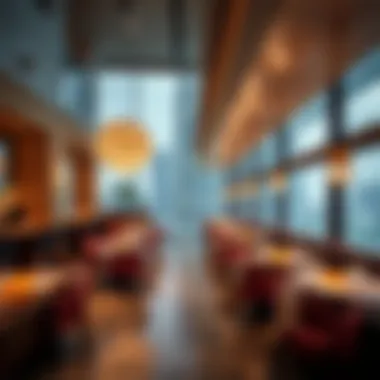Discover the Exciting New DIFC Restaurants in Dubai


Intro
The dining scene in Dubai is nothing short of exhilarating, and the Dubai International Financial Centre (DIFC) stands out as a epicenter for culinary innovation. With a mix of local flavors and international influences, DIFC's restaurants are crafting identities that reflect a fusion of the traditional and the avant-garde. Many are not just places to eat; they are experiences that mirror the fast-paced, cosmopolitan nature of Dubai itself.
As we journey through the newest eateries in this bustling financial hub, we'll uncover the nuances that set each apart. From their menus to interiors infused with culture and creativity, each restaurant contributes to a larger story about the evolution of Dubai's gastronomy. This article aims to provide a thorough look into these new establishments, offering insights into how they shape both the atmosphere and economy of DIFC.
Through exploring their unique characteristics, we will identify trends and changes that are redefining dining etiquette and expectations in the area. Whether you’re a local foodie, an investor eyeing the culinary landscape, or a visitor seeking memorable dining experiences, there’s much to savor in DIFC's burgeoning restaurant scene.
Prolusion to Dubai's DIFC
Dubai's flamboyant skyline is more than a visual feast; it’s a testament to ambition and economic prowess. Within this urban tapestry, the Dubai International Financial Centre (DIFC) stands as a pivotal player. Founded in 2004, DIFC is not just a financial district; it's a metropolitan magnet attracting global business, investment, and now, a culinary evolution unlike any other.
The Role of DIFC in Dubai's Economic Landscape
The DIFC plays a crucial role in shaping Dubai's economic identity. As a financial hub, it has established itself as a jurisdiction with a robust regulatory framework that aligns with international standards. This attracts foreign investment and large financial firms looking to expand their reach in the Middle East. Banks, hedge funds, and other financial services thrive here, but what's noteworthy is how this economic activity stimulates other sectors, including hospitality. The influx of professionals and international visitors has catalyzed a growing demand for quality dining experiences, making restaurants an integral part of DIFC's landscape.
Ideally situated, DIFC's location facilitates ease of access from various parts of Dubai. The proximity to major highways and public transport routes ensures that it’s a couple of steps from a bustling metro stop or an easy drive from the Dubai Mall, which enhances its allure for both locals and tourists alike. It's not merely a matter of convenience; this connectivity enhances the appeal of new DIFC restaurants, ensuring they capture a diverse clientele.
A Hub for Luxury Dining
One can't discuss the dining scene in DIFC without addressing the luxury aspect. The area is renowned for its high-end restaurants, each more enticing than the last, drawing in food connoisseurs from all walks of life. Established eateries like Zuma and La Petite Maison showcase a range of international flavors, from Japanese izakaya-style dining to French cuisine. However, the new players coming onto the scene promise to shake things up, introducing innovative concepts and cuisines that tantalize the taste buds.
Not only is the quality of food exceptional, but the dining experience is often complemented by picturesque views of the skyline and opulent settings that reflect Dubai's luxurious lifestyle. This harmonious blend of high-caliber cuisine and exquisite ambiance creates memorable dining experiences that resonate with the clientele.
In all, the DIFC is more than just offices and banks; it's a pulsating center of culture and gastronomy. As we journey through the new wave of restaurants blooming in this vibrant financial district, we can anticipate how they not only enhance the halal offerings but also contribute to the evolving tapestry of culinary adventures waiting to be explored.
"DIFC is not just about finance; it's where the culinary arcade begins, promising a delectable fusion of flavors and experiences."
As we move forward in this article, we will delve deeper into what to expect from new DIFC restaurants, unraveling the unique characteristics that define this exciting culinary realm.
What to Expect from New DIFC Restaurants
The Dubai International Financial Centre (DIFC) is fast becoming a landmark for culinary enthusiasts. As new restaurants pop up in this bustling hub, they bring with them a blend of flavors, styles, and trends that are revolutionizing the dining scene. These new establishments aren't just about food; they serve as a microcosm of Dubai’s vibrant culture, economic prowess, and social life. In this section, we’ll explore what sets these new DIFC restaurants apart by focusing on two essential aspects: innovative culinary trends and the captivating fusion of authenticity and modernity.
Innovative Culinary Trends
DIFC restaurants are diving headfirst into creative culinary trends that make every meal an adventure. Gone are the days when dining was just about filling the stomach; today, it’s a full-sensory experience. Restaurants are now experimenting with various concepts, emulating global influences while utilizing local resources. This fusion gives rise to dishes that tell stories, creating a culinary narrative that excites the palate.
Among these trends, the rise of plant-based menus stands out. Many new restaurants are leaning towards sustainability by incorporating more vegetarian and vegan dishes. This shift not only caters to a growing demographic looking for healthier options but also resonates with Dubai’s initiatives toward eco-friendliness. Imagine sitting in a sleek venue sipping on a basil-infused mocktail, enjoying a dish that highlights local spices, all while knowing you’re supporting responsible sourcing!
Furthermore, the integration of technology in the cooking process is also noteworthy. Restaurants are utilizing advanced culinary techniques such as molecular gastronomy and sous-vide cooking, creating an innovative dining affair. Dishes that seem simple on the surface may carry complex flavor profiles achieved through precision cooking methods. Patrons can expect not just a meal but an exciting exploration of food science.
Fusion and Authenticity
While innovation is key, the draw towards authentic flavors cannot be overstated. Many restaurants emerging in DIFC are committed to preserving traditional culinary practices while they play with modern mash-ups. This dual focus gives diners the best of both worlds.
For instance, one might encounter a sushi roll that employs local ingredients like za'atar instead of traditional sesame seeds, providing a new twist on a familiar favorite. Similarly, dishes like Arabic-style tacos that blend traditional spices and cooking methods with Mexican street food are making waves, showcasing how identity influences gastronomy in this cosmopolitan area.
“Food is more than sustenance; it’s about community and heritage.” This philosophy is at the heart of many DIFC dining experiences, where chefs invite diners into a cultural exchange through their innovative creations blending the best of local and international cuisines. By maintaining authenticity while mixing flavors and techniques, these restaurants are redefining what it means to enjoy a meal in a global city.
In summary, the new DIFC dining scene is a dynamic blend of trends that reflect a commitment to culinary excellence. Patrons can expect thoughtfully crafted meals that surprise and engage their senses, balanced by a strong foundation in authenticity and local traditions. From intriguing ambiance to innovative dishes, these new establishments offer a culinary journey that mirrors the vibrancy and diversity of Dubai itself.
Highlights of New Arrivals
As the Dubai International Financial Centre (DIFC) continues to evolve, the emergence of new restaurants is a key aspect that attracts attention from investors and food enthusiasts alike. These new dining spots add not just culinary diversity, but cultural dynamism to the area. Understanding these highlights of new arrivals provides critical insights into the shifting gastronomic landscape of Dubai.
New restaurants in DIFC often prioritize a blend of authenticity and innovation, creating unique dining experiences that resonate with both locals and visitors. This significance lies in several areas:


- Culinary Identity: Each new restaurant carries with it stories and flavors from different parts of the world. They craft menus that reflect cultural heritages while also embracing contemporary culinary practices.
- Economic Growth: New establishments stimulate the economy by providing jobs and supporting local suppliers. A thriving food scene can attract tourists and enhance the overall appeal of DIFC as a lifestyle destination.
- Social Dynamics: Restaurants serve as social hubs, where diverse groups come together. As new eateries open up, they invite people from various backgrounds to share meals, leading to increased cultural exchange.
Boutique Restaurants: A Personal Touch
Boutique restaurants in DIFC represent a refreshing shift from mainstream dining, focusing on creating intimate experiences. These little gems often prioritize quality over quantity. Culinary artisans behind these venues pour their heart and soul into each dish, aiming for something more personal.
For instance, consider a small eatery like Folly by Nick & Scott, which specializes in an innovative sharing menu inspired by Mediterranean flavors. Rather than overwhelming patrons with options, the restaurant curates a selection that changes seasonally. The cozy atmosphere combined with attentive service can transform a simple meal into an unforgettable experience.
- Personal touches like customized dishes based on diners’ preferences can make a significant impact.
- The design of the space often mirrors the ethos of the cuisine, creating a coherent dining narrative.
In recent trends, many of these boutique establishments also draw upon local influences and stories, adding layers to their identity. Incorporating regional produce not only enhances the menu but also connects the restaurant to its roots, amplifying the sense of place.
High-Profile Openings in DIFC
In contrast to boutique restaurants, high-profile openings tend to generate a buzz that can ripple across social media platforms and beyond. These are often spearheaded by renowned chefs or well-known restaurateurs who already have a reputation for culinary excellence. Their arrival in DIFC raises expectations, challenging local chefs and eateries to elevate their game.
For example, the anticipated opening of Zuma Dubai not only augments the dining choices available but also sets the standard for contemporary Japanese cuisine in the city. The excitement surrounding such openings stems from the expectation of high-quality dishes paired with a vibrant atmosphere.
- Expect a fusion of classic and modern in their menu offerings, carefully crafted to satisfy even the most discerning palates.
- The emphasis is not just on food but also on immersive dining experiences with well-thought-out interior designs and ambiance.
Such restaurants often become landmark destinations within DIFC, facilitating networking and socializing for high-powered professionals. They cater to the affluent clientele found in this financial hub, further reinforcing DIFC's image as a premier destination for luxury dining.
In summary, the highlights of new arrivals in DIFC reveal a layered tapestry of culinary ventures, each with its unique voice and narrative. From boutique spots that offer a personal touch to high-profile openings that draw the spotlight, each establishment plays a vital role in shaping Dubai's dining culture.
Signature Dishes to Sample
When it comes to the culinary landscape in Dubai’s DIFC, signature dishes hold a pivotal role. They serve as the very essence of what each restaurant strives to convey, offering diners not just a meal but an experience steeped in creativity and tradition. The signature dish, often crafted with the utmost care, carries the identity of the restaurant, inviting patrons to dive into a world of flavors that tell a story. This is where culinary artistry collides with meticulous attention to detail and ingredient quality.
To fully appreciate the significance of these dishes, it helps to understand what they represent:
- Culinary Identity: Each restaurant aims to stand out amidst a sea of options. Signature dishes are often the hallmark of a chef’s vision and culinary philosophy. For instance, a truffle-infused risotto not only showcases the chef's skill but also emphasizes the restaurant's commitment to high-quality, seasonal ingredients.
- Cultural Connection: Many signature dishes incorporate local or traditional elements. This connection to culture enriches the dining experience, allowing guests to explore the flavors originating from various cuisines while still grounding them within the context of modern gastronomy.
- Memorable Experiences: When diners think back on their meals, these standout creations often dominate their memory. A beautifully crafted saffron-infused seafood paella can create lasting impressions that not only fuel recommendations but also foster loyal patronage.
Iconic Flavors and Ingredients
A signature dish often hinges on a select few iconic flavors and ingredients that elevate a meal from ordinary to extraordinary. For instance, at a new DIFC eatery, you might find use of local spices blended into a contemporary interpretation of classic dishes. Ingredients such as sumac, za'atar, and saffron are not just decor; they play critical roles in providing depth and authenticity.
Some popular ingredients making waves are:
- Date Honey: Often used in desserts or glazes - its natural sweetness lends a luxurious touch.
- Sumac: This bright, tangy spice can bring freshness to a dish, making it a secret weapon in Mediterranean-inspired cuisines.
- Artisanal Cheese: Unique cheeses, whether made from sheep or goat’s milk, can add a notable richness and texture to various plates.
These flavors not only please the palate but also create a sensory bridge from the culinary creation back to its roots, creating tangible connections for diners.
Innovative Presentation Styles
As important as the flavors are, the presentation styles of these signature dishes have come to define the overall dining experience. In DIFC, visual aesthetics play a key role as restaurants seek to engage diners through vibrant plating techniques and innovative concepts. Imagine a dish served in a contemporary geometric bowl or food artfully arranged to resemble a modern landscape.
Here’s a glimpse into what’s trending:
- Deconstruction: A popular trend where classic dishes are deconstructed to showcase individual components artistically. For instance, a layered ice-cream dessert might be reimagined as a mini-art installation.
- Interactive Elements: Some chefs are adding fun twists, like edible mist or self-pour options, allowing diners to engage with their meals actively.
- Natural Elements: Current decor trends lean toward the organic. Restaurants might use slate tiles or wooden boards for serving, bringing the outdoors in and emphasizing a rustic charm.
In summary, signature dishes in the DIFC are not simply about feeding one’s hunger but rather crafting an experience. The combination of iconic flavors, distinctive ingredients, and cutting-edge presentation styles ensures that diners leave with memorable experiences that spark curiosity and delight. This elevates the dining venture into something more profound – a culinary journey that reflects the dynamic landscape of Dubai itself.
Cultural Influences in DIFC's Dining Scene
The dining landscape in the Dubai International Financial Centre (DIFC) is more than just a collection of new eateries; it is a vibrant tapestry woven from various cultural threads. This amalgamation enriches the gastronomical offerings, transforming each meal into a journey across continents. As these restaurants emerge, they serve not just food but also a narrative about the diverse influences that shape their menus and dining experiences.
Influence of International Cuisines


A stroll around DIFC reveals the sheer variety of international cuisines that have made their mark. From Japanese sushi bars to Italian trattorias, each establishment leverages techniques and flavors borrowed from afar. For instance, consider a restaurant that fuses traditional French culinary techniques with African spices; this melding not only reflects the chef's heritage but also embraces the multicultural essence of Dubai itself.
- Japanese izakayas explore the intersection of taste and community, emphasizing sharing and socializing through food.
- American barbecue joints have tailored their offerings to local preferences, introducing dishes that incorporate Middle Eastern spices while retaining that smoky barbecue essence.
Such international influences are pivotal in catering to a cosmopolitan patronage, ensuring that there’s something for everyone under DIFC’s culinary sky. This eclectic array also fosters an environment of culinary experimentation. Chefs are not bounded by convention; they often take creative liberties, crafting dishes that are as much about the experience as they are about the flavors.
"Culinary creativity often flourishes in the most unexpected places, making every dining experience in DIFC a unique adventure."
Local Ingredients and Their Significance
While the influence of international cuisines is indeed profound, the grounding force of local ingredients cannot be overstated. Restaurants in DIFC are increasingly conscious of sourcing produce and meat from local farms. This conscious choice not only supports the community but also ensures fresher, more flavorful dishes that resonate with the essence of the region.
- Ingredients like saffron, dates, and fresh fish from the Arabian Gulf often find their way into modern interpretations of classic recipes.
- Some restaurants have even adopted farm-to-table practices, where the connection between the growers and diners is emphasized, reflecting an appreciation for origin and quality.
The significance of this local sourcing is manifold. It fosters sustainable culinary practices and highlights the regional agricultural heritage, inviting diners to connect with the flavors of their surroundings. As more chefs recognize the value of local produce, DIFC's dining scene transforms into a testament to both culinary innovation and deep-rooted tradition.
In summary, when one explores the DIFC's dining scene, they are engaging in a dialogue that spans continents, cultures, and communities. Restaurants here are crafting culinary journeys that pay homage to global influences while also standing firm on local integrity. This blend creates a milieu that celebrates diversity and reflects Dubai's unique identity as a culinary hub.
Ambiance and Design of New DIFC Restaurants
The ambiance and design of new restaurants in the Dubai International Financial Centre (DIFC) play a crucial role in shaping the overall dining experience. It's not just about the food; it’s about how the environment complements what’s on the plate. The aesthetics, comfort, and vibe can elevate a meal, turning it into a memorable occasion. In a high-stakes area known for its luxury, the appearance and feeling of a restaurant can significantly influence a patron’s decision to return.
A well-thought-out design does more than just create a backdrop. It immerses guests in a story, one that reflects the restaurant's culinary vision. For instance, a restaurant that serves Asian fusion dishes might choose bamboo decor and soft, ambient lighting to evoke a sense of tranquility, while a high-energy grill might go for vibrant colors and contemporary art to stimulate excitement. It’s all about drawing patrons into a unique culinary narrative.
In this evolving dining landscape, new DIFC restaurants are making each detail count. Here are some prime elements to consider:
- Lighting: This can set the mood from romantic dinners to lively gatherings. Dim lighting may create intimacy, while bright, energizing lights can invigorate a space.
- Furniture and Layout: Comfort is king. Thoughtful arrangement ensures guests flow smoothly through the space, while high-quality furnishings can boost brand image.
- Art and Decor: Whether it’s local artists showcased on the walls or intricate table settings, decor becomes part of the dining experience. Unique touches can spark dialogue and interest among diners.
The ambiance is like a well-mixed cocktail; too much of one ingredient can ruin the balance. Understanding how to blend comfort, aesthetics, and functionality is essential for success.
Interior Style Trends
New DIFC restaurants are at the forefront of design trends, showcasing a melange of styles that delight the senses. There’s a noticeable lean toward minimalism, where the mantra is "less is more." Clean lines, simple color palettes, and uncluttered spaces are becoming the norm. This aesthetic can promote a sense of calm and luxury, making it attractive to high-profile diners who appreciate subtlety in their dining environments.
Meanwhile, there are those establishments embracing maximalism, where the motto can be considered "more is more." These spaces often flaunt vibrant hues, bold patterns, and an assortment of textures. Think of a restaurant that features exotic plants, textured walls, and eccentric artwork that transports diners to another world.
- Nature-Inspired Designs: Incorporating elements of nature, such as live plants or water features, is increasingly popular. This trend not only soothes but also promotes a sense of well-being.
- Sustainable Materials: Many new restaurants are focusing on eco-conscious design, using recycled or sustainably sourced materials for their interiors, aligning with the growing consumer demand for sustainability.
Creating a Dining Atmosphere
To create a successful dining atmosphere in new DIFC restaurants, it goes beyond mere design. Verily, it is about curating an experience where guests feel a connection—not just with their food but with their surroundings and the service.
A multi-sensory approach is essential. Here’s how restaurants are achieving this:
- Music: Carefully curated playlists can subtly influence emotions and enhance the overall mood. Louder, upbeat music might complement a lively brunch, while softer tones are ideal for romantic dinners.
- Service Style: The attitude and presentation of staff are pivotal. Friendly and attentive servers can make guests feel welcomed and cared for, while an overbearing approach can ruin a meal.
"A restaurant is a man-made paradise; the design whispers to the heart, while the service dances with the spirit of the diners."
By blending tranquil design elements with energetic service, new DIFC restaurants can create unique atmospheres that resonate with their patrons, turning casual meals into unforgettable experiences.
Sustainability Practices in New Restaurants
In the ever-evolving culinary landscape of DIFC, sustainability has become not just a buzzword but a vital practice. Restaurants serving this affluent area are increasingly prioritizing environmentally conscious efforts, resonating with the values of a socially-aware clientele. This focus on sustainability not only helps lessen the ecological footprint of dining establishments but also shapes their unique identities. By incorporating sustainable practices, these restaurants can enhance their market appeal while contributing positively to local and global efforts against climate change.
Eco-Friendly Sourcing of Ingredients
One of the cornerstones of sustainable dining is the sourcing of food ingredients. Many new restaurants in DIFC are adopting eco-friendly approaches to sourcing that prioritize local and organic products.


- Local Suppliers: Selecting ingredients from nearby farms minimizes transportation emissions and supports local economies. Restaurants like The Farm are leading the way by partnering with local farmers, offering a menu filled with fresh produce.
- Seasonal Menus: By focusing on what’s in season, chefs can create dishes that not only taste better but also require less resource-intensive production methods.
- Ethical Proteins: Many establishments are opting for meat and seafood sourced from certified sustainable fisheries or humane farms. This not only promotes animal welfare but also supports responsible fishing and farming practices.
These methods lead to fresher, tastier dishes, while positively impacting the environment. Not to mention, diners are increasingly drawn to these offerings, making them a smart business move in a competitive market.
Waste Management and Reduction Initiatives
Tackling waste is another critical aspect of sustainable practices in dining establishments. New DIFC restaurants are going above and beyond to minimize waste in several innovative ways:
- Composting: Various restaurants have embraced composting as a mainstay in their kitchen operations. This process diverts organic waste from landfills, turning it into nutrient-rich soil.
- Upcycling Ingredients: Chefs are becoming crafty, converting scraps into new dishes. For instance, vegetable peels can be used for stocks or sauces, ensuring that nothing gets wasted.
- Recycling and Donation Programs: Many establishments are partnering with organizations to donate surplus food to those in need, combining waste reduction with social responsibility.
"Addressing waste not only benefits the environment but can also improve the overall efficiency and profitability of a restaurant."
By implementing these waste management strategies, restaurants in DIFC are showing their commitment to sustainability and social conscience. Not only do these efforts create a more positive dining experience, but they also resonate well with an increasingly environmentally aware audience.
Through these sustainable practices, DIFC's new restaurants are setting benchmarks that transcend the traditional dining experience. They redefine what it means to enjoy food in a way that respects both the earth and its inhabitants.
Impact on the Local Community and Economy
The development of new restaurants within the Dubai International Financial Centre (DIFC) doesn’t just tantalize the taste buds; it ripples through the local community and economy. Understanding this impact is crucial for anyone involved in real estate, investment, or hospitality sectors in Dubai.
One key aspect to consider is the economic boost that these culinary establishments provide. As they open their doors, new job opportunities spring up, not only in the restaurants themselves but also in related sectors—from suppliers to event coordinators and beyond. In particular, the restaurant boom generates a range of employment roles that require a broad spectrum of skills. This is significant in a city like Dubai, known for its expatriate workforce. It becomes a melting pot of talent, with jobs spanning from chefs familiar with local flavors to waitstaff trained in high-end dining etiquette.
In terms of actual numbers, the DIFC's food and beverage sector has seen growth rates of over 10% in recent years, and this trend shows no signs of slowing. Many new restaurants are raising the bar when it comes to culinary arts, creating unique dining experiences that are attracting not just locals but also—and crucially—international tourists. This influx of visitors will naturally lead to increased spending in the area, fostering a healthy economic cycle.
Moreover, new eateries also serve as hubs for social interaction and community building, weaving a rich tapestry of gastronomic culture. They introduce diverse culinary traditions and flavors, creating a multi-cultural environment that stands as a testament to Dubai’s melting pot status. This diversity is not just beneficial for the patrons; it also allows chefs and restaurateurs to experiment with new concepts that reflect global trends while offering a nod to local tastes.
On the other hand, the local community benefits in subtler ways as well. When restaurants utilize local ingredients, it supports regional farmers and suppliers, further anchoring the relationship between dining and the local economy. Consumers become more aware of sustainability issues as well, encouraging businesses to adopt eco-friendly practices.
In summary, the launch of new restaurants in DIFC serves as a catalyst for positive change. It elevates employment rates, enhances the quality of life, and builds a vibrant community atmosphere. Simply put, these dining establishments are not just places to eat; they are pivotal in enhancing the local economy and forging connections within the community.
Creating Employment Opportunities
With every new restaurant that opens its doors, a wave of employment opportunities follows suit. In DIFC, this process is not merely a byproduct but a central feature of the restaurant landscape. These establishments are variously staffed—offering positions for chefs, kitchen hands, managers, and service personnel. Each job not only adds to the economic fabric but also helps individuals gain valuable skills and experience that can contribute to their livelihood.
Moreover, these positions often promote career advancement. Many restaurant workers start in entry-level roles and gradually work their way up, motivated by a vibrant culinary culture that favors creativity and innovation. This growth helps build a skilled workforce and brings positive change to the economy.
Enhancing the Cultural Fabric of DIFC
As the dining scene evolves, it significantly enriches the cultural landscape of the DIFC. Restaurants often showcase various culinary traditions, contributing to the multicultural identity of Dubai. They can be regarded as cultural ambassadors, offering authentic experiences while celebrating local heritage. Here, food becomes a universal language that unites diverse communities.
Additionally, cultural events held in restaurants, from food festivals to art exhibitions, foster a sense of belonging among community members. Such initiatives strengthen interpersonal connections and elevate the overall dining experience beyond mere consumption. With each new restaurant, DIFC positions itself not just as a financial hub but as a cultural nexus, positively impacting the richness of experience available to residents and visitors alike.
The End: The Future of Dining in DIFC
The dining landscape in Dubai's International Financial Centre (DIFC) is not merely evolving; it’s transforming into a vital aspect of the broader economic ecosystem. This transformation ensures that every new restaurant that opens its doors does not just serve meals, but also contributes significantly to the cultural dialogue of the city. The integration of innovative culinary perspectives alongside deeply rooted traditions embraces diversity, directing attention to aspects that investors, real estate agents, and market analysts should take note of.
Anticipated Trends to Watch
As we look ahead, several trends stand out, promising to shape the way DIFC dining continues to unfold.
- Health-Conscious Offerings: With an increasing emphasis on wellness, restaurants are expected to innovate dishes that reflect a balance between indulgence and nutrition. Expect organic ingredients and options that cater to dietary restrictions becoming the norm.
- Technology Integration: Expect to see advanced tech solutions making their way into restaurants. From digital menus to contactless payments, technology will enhance the overall dining experience and streamline operations.
- Experiential Dining: Diners now seek not just food, but an experience. The rise of culinary events, cooking classes, and themed nights will likely gain momentum, pushing restaurants to create memorable experiences that extend beyond the plate.
- Sustainability Focus: Diners are looking for restaurants that prioritize eco-friendly practices. This includes sustainable sourcing, waste reduction, and even using plant-based ingredients, all of which can create a positive brand image and a loyal customer base.
Each of these anticipated trends indicates not just a passing phase but a sustained shift that could influence investments in the area, signaling what may hold potential for profitability.
Committing to Culinary Excellence
Culinary excellence is more than a buzzword; it’s the cornerstone upon which DIFC’s dining success will be built. New restaurants are recognizing that setting a high standard in food quality is essential for longevity in such a competitive market.
- Focus on Local Sourcing: An increasing number of establishments are committing to sourcing locally, which enhances flavor, nurtures community ties, and supports the local economy.
- Chef Innovation: Talented chefs continue to push boundaries through creativity and technique. Their dedication to crafting unique and flavorful dishes will be a vital ingredient in DIFC’s culinary success story.
- Customer-Centric Approaches: Engaging with customers through feedback, adapting menu offerings, and creating personalized experiences will differentiate those who thrive from those who fade into the background.
- Culinary Education: There’s also a growing emphasis on professional development within the culinary field. As chefs and restaurant staff engage in continual learning, the quality of dining experiences will inevitably rise.
"The future of dining in DIFC hinges on culinary excellence and adaptability, ensuring that the offerings resonate with both tradition and tomorrow's tastes."
In wrapping up, the narrative of dining in DIFC is not just a chapter; it’s a multifaceted story that is still being written. The focus on evolving trends, culinary excellence, and the community's commitment will set the stage for a dining experience that is not only memorable but also integral to Dubai’s vibrant culture and economy. With careful observation and responsive action, the community can anticipate a bright future on the culinary front.











